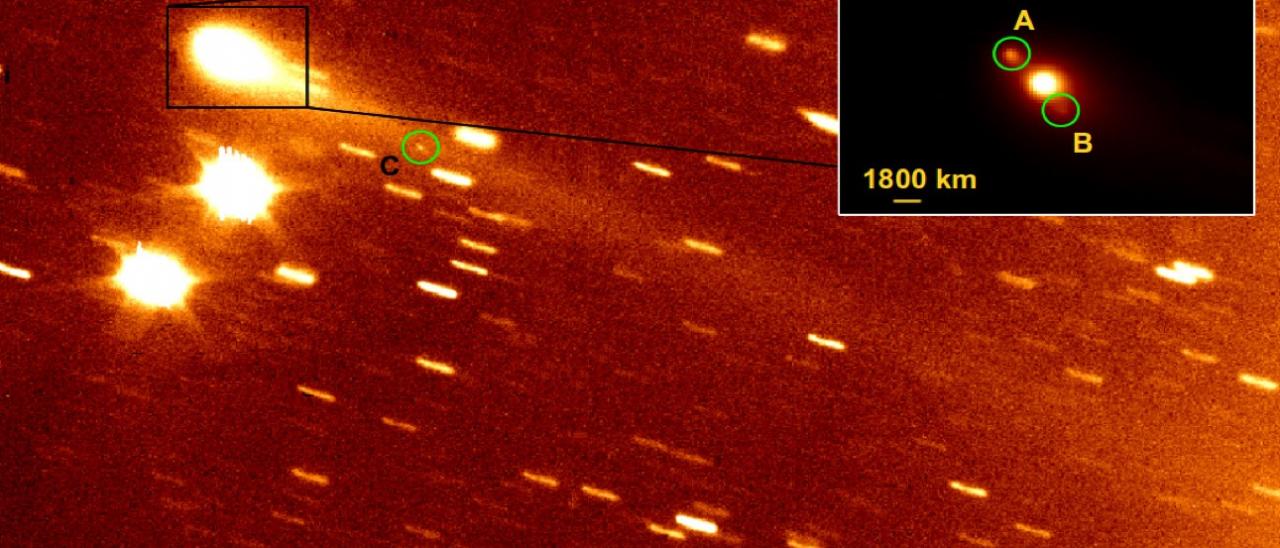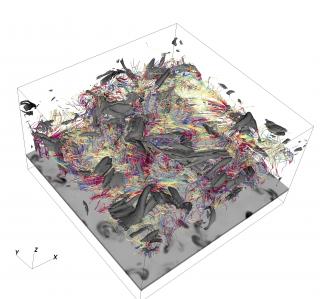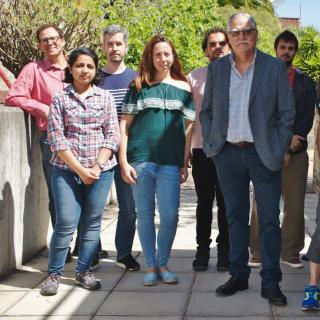Grants related:
General
This project studies the physical and compositional properties of the so-called minor bodies of the Solar System, that includes asteroids, icy objects, and comets. Of special interest are the trans-neptunian objects (TNOs), including those considered the most distant objects detected so far (Extreme-TNOs or ETNOs); the comets and the comet-asteroid transitional objects (Centaurs and main belt comets or MBCs); the primitive asteroids. The last two groups contain the most primordial and pristine material of the Solar System and so they provide the clues to understand the origin and the subsequent evolution of our system. Among asteroid population, the near-Earth asteroids or NEAs, as well as the potentially hazardous asteroids (PHAs) are of particular interest: due to their proximity to the Earth, they are the most accesible to spacecraft and so are ideal for in-situ or even sample-return space missions. In addition they are considered as future potential resources of materials (asteroid mining), and they are also impact hazards for the Earth. Regarding primitive asteroids, it is remarkable the spectroscopic survey (visible and near-infrared) led by the PI of this project (PRIMitive Asteroids Spectroscopic Survey - PRIMASS). This survey received financial support from NASA (17-PDART17_2-0097, PI: N. Pinilla-Alonso, 137.000€ - 2 years) in order to upload and archive at the Small Bodies Node of the NASA Planetary Data System the more than 800 spectra obtained.
The compositional surface properties, as well as the physical and thermal properties of these objects are inferred through imaging, photometry, and spectroscopy in a wide range of wavelengths (from 0.35 up to 24 microns). Data are interpreted using scattering and thermo-physical models. This project works also in the study of the physical properties of the cometary nuclei, as well as properties of dust and coma in the tails of the MBCs and the mechanisms that generate them.
This group maintains several international collaborations with other groups, and some of their members are also members of (1) the Science Team of the NASA OSIRIS-REx mission, in particular the Image Processing Working Group, were they work with the images obtained with the OCAMS suite of cameras; (2) the coordination of an international group to study NEAs (EURONEAR); (3) the central core of the proponents of ESA M5 missions CASTALIA, CASTAway, and Hera; (4) the Center for Lunar and Asteroid Surface Science - CLASS (NASA); (5) the Solar System group of the Euclid consortium; (6) the surveys J-PLUS and J-PASS for the exploitation of observations of Solar System objects; (7) the Solar System working group of Gaia and JWST.
Members
Scientific activity
Related publications
-
Expected spectral characteristics of (101955) Bennu and (162173) Ryugu, targets of the OSIRIS-REx and Hayabusa2 missions
NASA's OSIRIS-REx and JAXA's Hayabusa2 sample-return missions are currently on their way to encounter primitive near-Earth asteroids (101955) Bennu and (162173) Ryugu, respectively. Spectral and dynamical evidence indicates that these near-Earth asteroids originated in the inner part of the main belt. There are several primitive collisional
de León, J. et al.Advertised on:
102018 -
PRIMASS visits Hilda and Cybele groups
The Cybele and Hilda dynamical groups delimit the outer edge of the asteroid belt. Their compositional distribution is a key element to constrain evolutionary models of the Solar System. In this paper, we present a compositional analysis of these populations using spectroscopic observations, SDSS and NEOWISE data. As part of the PRIMASS (Primitive
De Prá, M. N. et al.Advertised on:
92018 -
Visible spectroscopy of the Sulamitis and Clarissa primitive families: a possible link to Erigone and Polana
The low-inclination (i < 8∘) primitive asteroid families in the inner main belt, that is, Polana-Eulalia, Erigone, Sulamitis, and Clarissa, are considered to be the most likely sources of near-Earth asteroids (101955) Bennu and (162173) Ryugu. These two primitive NEAs will be visited by NASA OSIRIS-REx and JAXA Hayabusa 2 missions, respectively
Morate, D. et al.Advertised on:
22018 -
New polarimetric and spectroscopic evidence of anomalous enrichment in spinel-bearing calcium-aluminium-rich inclusions among L-type asteroids
Asteroids can be classified into several groups based on their spectral reflectance. Among these groups, the one belonging to the L-class in the taxonomic classification based on visible and near-infrared spectra exhibit several peculiar properties. First, their near-infrared spectrum is characterized by a strong absorption band interpreted as the
Devogèle, M. et al.Advertised on:
42018 -
Visible spectra of (474640) 2004 VN112-2013 RF98 with OSIRIS at the 10.4 m GTC: evidence for binary dissociation near aphelion among the extreme trans-Neptunian objects
The existence of significant anisotropies in the distributions of the directions of perihelia and orbital poles of the known extreme trans-Neptunian objects (ETNOs) has been used to claim that trans-Plutonian planets may exist. Among the known ETNOs, the pair (474640) 2004 VN112-2013 RF98 stands out. Their orbital poles and the directions of their
de León, J. et al.Advertised on:
52017 -
280 one-opposition near-Earth asteroids recovered by the EURONEAR with the Isaac Newton Telescope
Context. One-opposition near-Earth asteroids (NEAs) are growing in number, and they must be recovered to prevent loss and mismatch risk, and to improve their orbits, as they are likely to be too faint for detection in shallow surveys at future apparitions. Aims: We aimed to recover more than half of the one-opposition NEAs recommended for
Vaduvescu, O. et al.Advertised on:
12018 -
Disrupted Asteroid P/2016 G1. II. Follow-up Observations from the Hubble Space Telescope
After the early observations of the disrupted asteroid P/2016 G1 with the 10.4 m Gran Telescopio Canarias (GTC) and modeling of the dust ejecta, we have performed a follow-up observational campaign of this object using the Hubble Space Telescope (HST) during two epochs (2016 June 28 and July 11). The analysis of these HST images with the same model
Moreno, F. et al.Advertised on:
122017 -
The EURONEAR Lightcurve Survey of Near Earth Asteroids
This data paper presents lightcurves of 101 near Earth asteroids (NEAs) observed mostly between 2014 and 2017 as part of the EURONEAR photometric survey using 11 telescopes with diameters between 0.4 and 4.2 m located in Spain, Chile, Slovakia and Romania. Most targets had no published data at the time of observing, but some objects were observed
Vaduvescu, O. et al.Advertised on:
82017 -
Physical and dynamical properties of the anomalous comet 249P/LINEAR
Images and low-resolution spectra of the near-Earth Jupiter family comet (JFC) 249P/LINEAR in the visible range obtained with the instrument OSIRIS in the 10.4 m Gran Telescopio Canarias (GTC) (La Palma, Spain) on January 3, 4, 6 and February 6, 2016 are presented, together with a series of images obtained with the 0.4m telescope of the Great
Fernández, Julio A. et al.Advertised on:
102017 -
Meteor studies in the framework of the JEM-EUSO program
We summarize the state of the art of a program of UV observations from space of meteor phenomena, a secondary objective of the JEM-EUSO international collaboration. Our preliminary analysis indicates that JEM-EUSO, taking advantage of its large FOV and good sensitivity, should be able to detect meteors down to absolute magnitude close to 7. This
Abdellaoui, G. et al.Advertised on:
92017 -
V-type candidates and Vesta family asteroids in the Moving Objects VISTA (MOVIS) catalogue
Context. Basaltic asteroids (spectrally classified as V-types) are believed to be fragments of large differentiated bodies. The majority of them are found in the inner part of the asteroid belt, and are current or past members of the Vesta family. Recently, some V-type asteroids have been discovered far from the Vesta family supporting the
Licandro, J. et al.Advertised on:
42017 -
The 67P/Churyumov-Gerasimenko observation campaign in support of the Rosetta mission
We present a summary of the campaign of remote observations that supported the European Space Agency's Rosetta mission. Telescopes across the globe (and in space) followed comet 67P/Churyumov-Gerasimenko from before Rosetta's arrival until nearly the end of the mission in September 2016. These provided essential data for mission planning, large
Snodgrass, C. et al.Advertised on:
52017 -
Non-Vestoid candidate asteroids in the inner main belt
Context. Most howardite-eucrite-diogenite (HED) meteorites (analogues to V-type asteroids) are thought to originate from the asteroid (4) Vesta. However some HEDs show distinct oxygen isotope ratios and therefore are thought to originate from other asteroids. In this study we try to identify asteroids that may represent parent bodies of those
Oszkiewicz, D. A. et al.Advertised on:
32017 -
The Splitting of Double-component Active Asteroid P/2016 J1 (PANSTARRS)
We present deep imaging observations, orbital dynamics, and dust-tail model analyses of the double-component asteroid P/2016 J1 (J1-A and J1-B). The observations were acquired at the Gran Telescopio Canarias (GTC) and the Canada–France–Hawaii Telescope (CFHT) from mid-March to late July of 2016. A statistical analysis of backward-in-time
Moreno, F. et al.Advertised on:
32017 -
The Remote Observatories of the Southeastern Association for Research in Astronomy (SARA)
We describe the remote facilities operated by the Southeastern Association for Research in Astronomy (SARA) , a consortium of colleges and universities in the US partnered with Lowell Observatory, the Chilean National Telescope Allocation Committee, and the Instituto de Astrofísica de Canarias. SARA observatories comprise a 0.96 m telescope at Kitt
Keel, W. C. et al.Advertised on:
12017 -
The JEM-EUSO mission: An introduction
The Extreme Universe Space Observatory on board the Japanese Experiment Module of the International Space Station, JEM-EUSO, is being designed to search from space ultra-high energy cosmic rays. These are charged particles with energies from a few 1019 eV to beyond 1020 eV, at the very end of the known cosmic ray energy spectrum. JEM-EUSO will also
Adams, J. H. et al.Advertised on:
112015 -
The JEM-EUSO instrument
In this paper we describe the main characteristics of the JEM-EUSO instrument. The Extreme Universe Space Observatory on the Japanese Experiment Module (JEM-EUSO) of the International Space Station (ISS) will observe Ultra High-Energy Cosmic Rays (UHECR) from space. It will detect UV-light of Extensive Air Showers (EAS) produced by UHECRs
Adams, J. H. et al.Advertised on:
112015 -
The atmospheric monitoring system of the JEM-EUSO instrument
The JEM-EUSO telescope will detect Ultra-High Energy Cosmic Rays (UHECRs) from space, detecting the UV Fluorescence Light produced by Extensive Air Showers (EAS) induced by the interaction of the cosmic rays with the earth's atmosphere. The capability to reconstruct the properties of the primary cosmic ray depends on the accurate measurement of the
Adams, J. H. et al.Advertised on:
112015 -
The infrared camera onboard JEM-EUSO
The Extreme Universe Space Observatory on the Japanese Experiment Module (JEM-EUSO) on board the International Space Station (ISS) is the first space-based mission worldwide in the field of Ultra High-Energy Cosmic Rays (UHECR). For UHECR experiments, the atmosphere is not only the showering calorimeter for the primary cosmic rays, it is an
Adams, J. H. et al.Advertised on:
112015 -
Calibration aspects of the JEM-EUSO mission
The JEM-EUSO telescope will be, after calibration, a very accurate instrument which yields the number of received photons from the number of measured photo-electrons. The project is in phase A (demonstration of the concept) including already operating prototype instruments, i.e. many parts of the instrument have been constructed and tested
Adams, J. H. et al.Advertised on:
112015



